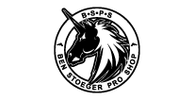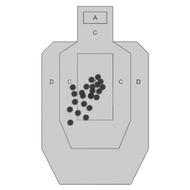The Dreaded Shooting Low and Left by Joel Park
Posted by Joel Park on Jun 4th 2023
The Dreaded Shooting Low and Left
I have the opportunity to interact with quite a few shooters from novice to pro and there are some common issues that most people seem to struggle with at one time or another. Shots hitting low left are a very common issue. There are several suggested remedies to fix the issue; they range from just slowing down, using snap caps mixed in with live ammo while practicing at the range and just shooting more with hopes of the issue resolving itself.
For most shooters, the root cause of the issue comes from either pushing into the gun in an attempt to stop it from recoiling up or from changing the tension in the firing hand. In reality, handguns don’t really recoil that much, but the noise and blast from the gun firing can cause shooters to want to stop it from moving. This can result in the shooter pushing into the gun before or during recoil and the amount of force applied doing so pushes the shots low left. Some shooters also change the tension in their fingers and hand, resulting in them essentially using their entire hand to fire the gun. The act of making a fist with your firing hand while shooting will affect where the bullets land.
A simple demonstration to illustrate how little a handgun recoils is: take all the time you need gently pressing the trigger to fire a single shot as perfectly as you can, at a 7-yard target, but do not apply ANY resistance to the gun and let it recoil naturally. Then, fire a second shot, as perfectly as you can, to mark how much the gun recoiled. Do the test a few times to make sure you are getting a consistent result and take a very hard look at how much the gun lifted in recoil. Now, stand at the 7-yard line and only move the sights between the two spots without firing the gun and notice how little effort is needed from you to return the sights to your aiming point. Compare that to how much force you previously thought you needed to apply to stop recoil and you will notice there is a very big difference.
Now that you understand it isn’t necessary to push into the gun to stop it from recoiling, I recommend you return the gun with only your eyes. I realize it might sound crazy, so let me explain; if you look at any object then bring your finger up to point at it, there is basically no effort needed to make your finger point at the object. Your eyes just steer to where you’re looking. With the minimal amount of effort needed to return the gun, you can do the same thing by just staring at the point you want to hit and letting your hands steer the sights to where you are looking.
Now we need to tackle the second part of not reacting to the recoil or noise of the handgun going off. There is a very simple drill called Trigger Control at Speed that’s quite effective.
The drill starts by aiming at a target in your normal two-handed grip with your finger in the trigger guard. Reacting to the tone from a random par time, you need to press the trigger as fast as you possibly can without moving the sights. You should judge your success by how much or how little the sights move as you press the trigger in dryfire.
There are a few things to note, the drill only works if you react as soon as you hear the tone from the par time. If you’re not attempting to have the trigger pressed all way through the break before the tone of the beep is over, you’re not emphasizing the importance of time. A delayed or slow reaction at a comfortable pace isn’t going to expose any of your weaknesses. After all, you can always “slow down to get your hits” if that’s your thing.
As you do the drill, you will likely catch yourself pushing into the gun or feel your firing hand tense up. I suggest putting all your conscious thought into your firing hand while you do the drill. If you are aware of the problem, you will stop doing it. A useful cue is relaxing your firing hand as much as you can, so you can press the trigger using only your trigger finger and not having the rest of the fingers in your hand tense up or move.
Practicing the drill for 3-5 minutes will be a lot of reps and your hands will likely start to get tired. I recommend working on it for a few minutes each dryfire session or inside the safe area at a match. This isn’t a drill you need to practice for hours. I also recommend changing the starting position of your trigger finger as you train using the drill. Start with your finger resting on the trigger, with space between your finger and the trigger, and with your trigger all the way in the front of the trigger guard. For most shooters, the difficulty increases as you move your finger farther away from the trigger.
This is also a drill you can do during live fire on the range. The procedure is exactly the same and the goal is to stack your shots exactly on the spot you were aiming at. Doing 5-10 one shot repetitions with live ammo then switching back to dryfire is a good way to validate the results you are getting in dryfire. It will also make your dry training feel more real when you switch back to dryfire after just firing live ammo.
For most of us, firing buckets of ammo isn’t feasible. By directing your attention to specific areas and closely monitoring the results, you can make significant improvements to your marksmanship ability with minimal cost, other than your time.

